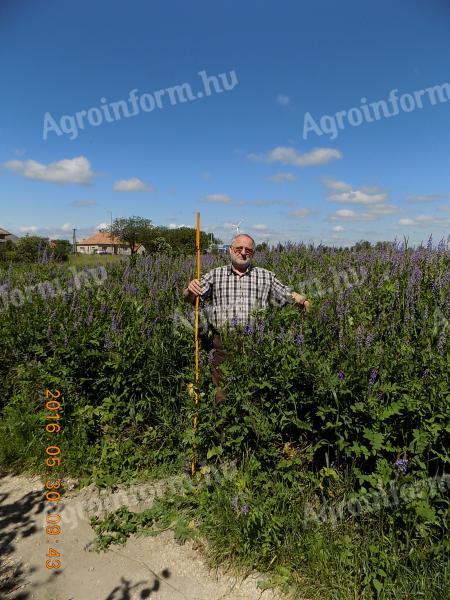Goat's Rue (Perennial, Butterfly, up to 15-20 years)
 Győr-Moson-Sopron county, 9200 Mosonmagyaróvár
Győr-Moson-Sopron county, 9200 Mosonmagyaróvár
 10
10
| Price |
65.000 HUF |
| Quantity offered for sale |
4.000 |
| Quantity unit |
Bag |
Description
PLANT (installed for 15-20 years), PLEASURE!
FACTORS NOT TO BE NEGLECTED FOR SUBSIDY PURPOSES!
IN MAIN CROP: FROM THE END OF MARCH TO MID-MAY, IN SECOND CROP: FROM THE END OF JULY TO MID-SEPTEMBER! You can apply for a PLEASANT GRANT and also participate in the AKG PROGRAMME!
Yield: 55-75 tonnes/ha/year from the second year (2 mowings). First mowing mid-May, second mowing end of July, grazing from September in the 3rd year. Thanks to its intensive growth, from the second year it can be grown without herbicides!
Optimum soil pH: between 6 and 7.5, high yields can be expected! If the soil pH differs from this value, N fertiliser must be added.
In the year of sowing, maize can be sown as an intercrop (maize has a constant supply of nitrogen, less weed infestation, higher green weight can be harvested). Can also be grown in combination with other forage grasses.
Yield: 75,5 t green yield = 17,4 t hay.
Protein content of 1st mowing: 27.8%, protein content of 2nd mowing: 27.4%.
Mowing 3 produces 70-80 t/ha green yield, of which 18.7% dry matter. Dry matter composition (18.7%): 4.6% protein, 0.49% fat, 4.8% fibre, 6.91% N-free extractable matter, 1.9% ash.
Green contains 23-24% protein.
16-20 t/ha dry matter.
PROTEIN YIELDS: GOAT'S KIDNEY: 3.8 t/ha, LUCERNA: 2.9 t/ha, VÖRÖSHERE: 2.3 t/ha.
METABOLISABLE ENERGY: KECSKERUTA: 118 GJ/ha, LUCERNA: 117 GJ/ha, VÖRÖSHERE: 110 GJ/ha.
Protein content: Goat's Rue 25%, Lucerne: 20%. Red clover: 16.5%.
AMINO ACID COMPOSITION: LIZIN: Goat's rue: 10,8 g/kg. Lucerne: 7,3-9,1 g/kg. Red clover: 8,6 g/kg.
Goat's rue contains more than alfalfa: Lysine, Methionine, Valine, Methylalanine.
Goat's rue contains the same amounts of isoleucine and leucine as lucerne.
Support: CAP direct aids (2017-2020) "Growing of protein crops for fibre", Annex 7, line 22 of Decree 9/2015 (13.III.) of the Ministry of Agriculture, Food and Rural Development, and from 2018, POPULATION FROM PERSONAL PLANT TO PERMANENT CULTURE!
THE PRICE IS INCLUDING 1 ha OF PLANT + SPECIFIC OIL SUPPLY!!!
(pictures of the 8-15 cm crop sown on 6 August 2016) WE CAN USE THE AREA ALL YEAR LONG, WITH NO FUN WITH FUNGUS, WE CAN USE IT FOR BIO-GROWING!!!
The soil preparation, pre-sowing requirements, sowing (planting) of the KELETI KECSKERUTA (Galega orientalis L.) can be considered identical to those of alfalfa. The difference is that it can be sown from spring to autumn (April to mid-September), at any time (preferably as early as possible to take advantage of winter rainfall, during the rainy season, possibly with irrigation, or before autumn rainfall in August). The great advantage of this crop is that it has an economic life of 15-20 years, not 3-4! Its excellent frost and drought tolerance is remarkable from the second year onwards, and its deep-rooted tarragon root system means that it does not 'wear out', increasing its area and density year on year. A green mass of 50-75 t/ha (22-26% protein) can be harvested annually with two mowings, with the same feed value as alfalfa. When making hay, the leaves do not curl at all. It is an excellent dairy feed, but can be recommended for all livestock species. It is lactogenic, which increases milk secretion, and also increases milk fat. It can also be fed green, as hay or haylage, as required, to any farm animal species.
In the early stages of green budding or flowering, it can be salted (packaged) to obtain a feed with excellent nutritional value (protein, amino acid composition, minerals, trace elements, vitamins, carotene).
Second or, in many cases, third growth, it is grazable and does not cause bloat, unlike alfalfa. It can be used in pasture mixtures, perennial mowing mixtures, as a butterfly component.
Suitable for high nutritional value green meal, pellets!
It is also considered an excellent honey plant.
Its yield security, hardiness and adaptability are unrivalled by any butterfly forage crop.
We market and breed seeds of the best varieties, together with the most effective nitrogen-fixing bacteria.
For planting, we provide the specific rhizobium inoculant (Rhisobium galegae).
Pre-ordering, expert advice and presentation of reference sites.
The dated photos show the first growth of an eastern goatweed stand in its 11th year of production, in different years (May 6, 2017 was the 11th year that we planted it. The scale is 2.0 m, I am 173 cm tall myself).
In our isolated area we planted 1 mother plant separately 11 years ago, today it occupies an area of 5 m2 without nutrient replenishment, this year again - despite the extreme drought - the first growth grew to 172 cm (see pictures).
We exclusively reserve the right to breed, domesticate and develop the technology, which we have published in several publications and textbooks!
PLEASE place your pre-orders now for the post-harvest planting of the cereals in August-early September this year, so that we can fully meet the growing demand!
Identifier: 6506864
Updated: 20 June 2025 at 17:30:12 CEST























